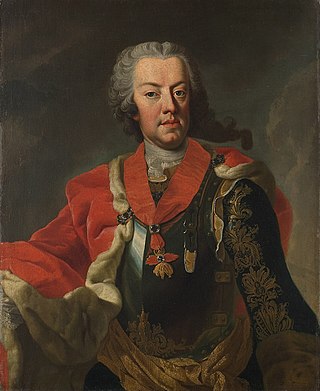
Prince Charles Alexander Emanuel of Lorraine was a Lorraine-born Austrian general and soldier, field marshal of the Imperial Army, and governor of the Austrian Netherlands.
The Treaty of Hubertusburg was signed on 15 February 1763 at Hubertusburg Castle by Prussia, Austria and Saxony to end the Third Silesian War. Together with the Treaty of Paris, signed five days earlier, it marked the end of the Seven Years' War. The treaty ended the continental conflict with no significant changes in prewar borders. Austria and Saxony renounced all claims to the Silesian territories ceded to Prussia in the 1742 Treaty of Berlin and the 1745 Treaty of Dresden. Prussia clearly stood among the ranks of the European great powers, while the treaty enhanced the rivalry with Austria.

The Battle of Kolín (Kolin) on 18 June 1757 saw 54,000 Austrians under Count von Daun defeat 34,000 Prussians under Frederick the Great during the Third Silesian War. Prussian attempts to turn the Austrian right flank turned into piecemeal frontal attacks and were defeated in five and a half hours of combat. The Prussians lost 13,733 men, the Austrians 8,100. Frederick gave up the siege of Prague as well as his planned march on Vienna and retreated to Saxony.

The Battle of Moys was fought on 7 September 1757 during the Third Silesian War. A Prussian army of 13,000 men fought an Austrian army of double their size. The Prussians were defeated and their commander killed.

The Battle of Breslau was fought on 22 November 1757 in Breslau during the Third Silesian War. A Prussian army of 28,000 men fought an Austrian army of 60,000 men. The Prussians held off the Austrian attack, losing 6,000 men to the Austrians' 5,000 men. But one day later the Prussians beat a retreat. Breslau's garrison surrendered on 25 November 1757.

The Battle of Leuthen was fought on 5 December 1757 between Frederick the Great's Prussian Army and an Austrian army commanded by Prince Charles of Lorraine and Count Leopold Joseph von Daun. Frederick used maneuver warfare and knowledge of the terrain to rout the larger Austrian force completely. The victory ensured Prussian control of Silesia during the Third Silesian War, which was part of the Seven Years' War.

The Battle of Zorndorf, during the Seven Years' War, was fought on 25 August 1758 between Russian troops commanded by Count William Fermor and a Prussian army commanded by King Frederick the Great. The battle was tactically inconclusive, with both armies holding their ground and claiming victory. The site of the battle was the Prussian village of Zorndorf. During the battle, Frederick famously took a regimental standard and led an attack himself, rallying his troops.
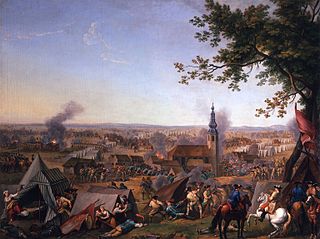
The Battle of Hochkirch took place on 14 October 1758, during the Third Silesian War. After several weeks of maneuvering for position, an Austrian army of 80,000 commanded by Lieutenant Field Marshal Leopold Josef Graf Daun surprised the Prussian army of 30,000–36,000 commanded by Frederick the Great. The Austrian army overwhelmed the Prussians and forced a general retreat. The battle took place in and around the village of Hochkirch, 9 kilometers (6 mi) east of Bautzen, Saxony.
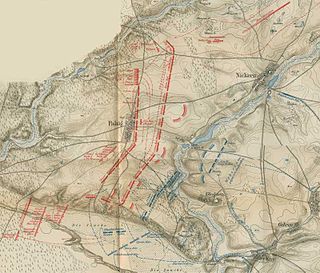
The Battle of Kay, also referred to as the Battle of Sulechów, Battle of Züllichau, or Battle of Paltzig, was an engagement fought on 23 July 1759 during the Seven Years' War. It occurred near Kay (Kije) in the Neumark, now part of Poland.

The Battle of Maxen was a battle at Maxen, in the Electorate of Saxony during the Third Silesian War. It resulted in surrender of a Prussian corps.

The Battle of Chotusitz, or Chotusice, sometimes called the Battle of Čáslav, took place on 17 May 1742, in Bohemia, now the Czech Republic; it was part of the 1740 to 1742 First Silesian War, itself a subsidiary of the wider War of the Austrian Succession.

Count Leopold Joseph von Daun, later Prince of Thiano, was an Austrian field marshal of the Imperial Army in the War of the Austrian Succession and Seven Years' War. Daun is considered one of the outstanding military leaders from his time.

Franz Moritz Graf von Lacy was a Baltic German-born Austrian military leader, he was the son of Count Peter von Lacy and was a famous Austrian field marshal. He served during the reign of Maria Theresa and was a close friend to Joseph II, Holy Roman Emperor, becoming one of the latter's advisers. Lacy was made a count of the Holy Roman Empire.
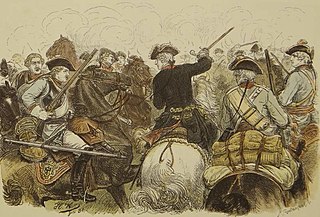
The First Silesian War was a war between Prussia and Austria that lasted from 1740 to 1742 and resulted in Prussia's seizing most of the region of Silesia from Austria. The war was fought mainly in Silesia, Moravia and Bohemia and formed one theatre of the wider War of the Austrian Succession. It was the first of three Silesian Wars fought between Frederick the Great's Prussia and Maria Theresa's Austria in the mid-18th century, all three of which ended in Prussian control of Silesia.

The Third Silesian War was a war between Prussia and Austria that lasted from 1756 to 1763 and confirmed Prussia's control of the region of Silesia. The war was fought mainly in Silesia, Bohemia and Upper Saxony and formed one theatre of the Seven Years' War. It was the last of three Silesian Wars fought between Frederick the Great's Prussia and Maria Theresa's Austria in the mid-18th century, all three of which ended in Prussian control of Silesia.
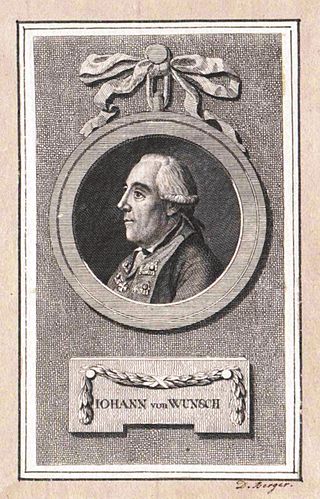
Johann Jakob von Wunsch (1717–1788) was soldier of fortune and Prussian general of infantry, and a particularly adept commander of light infantry. The son of a Württemberg furrier, he served in several armies in the course of his lengthy career.
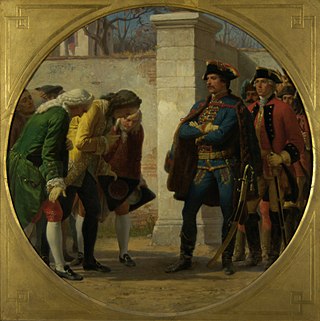
The 1757 raid on Berlin took place during the Third Silesian War. Cavalrymen of the Holy Roman Empire attacked and briefly occupied Berlin, the capital of Prussia.

Events from the year 1757 in Austria

Johann Paul von Werner was chief of the Prussian Hussar Regiment No. 6 ; he also received the Prussian Order Pour le Mérite. Initially in Austrian service, he fought against Spain, France, the Ottoman Empire and against Prussia. One of Frederick the Great's trusted diplomats, Hans Karl von Winterfeldt, recruited him into Prussian service in 1750; subsequently, he fought for Prussia against the Austrians in the Seven Years' War and the War of Bavarian Succession. He was wounded once, and taken prisoner several times. The Prussian playwright Gotthold Lessing modeled the character of the sergeant in his Minna von Barnhelm on Werner.
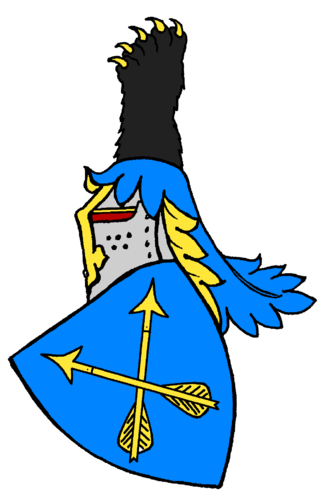
Soloman Sprecher von Bernegg was a Habsburg military commander in the War of Austrian Succession and the Seven Years' War.





















